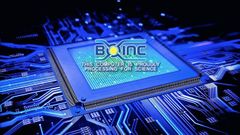GridCoin

GridCoin (sign: Ǥ, symbol: GRC) is a cryptocurrency that uses blockchain technology to crowdsource calculations of scientific projects. The Gridcoin Protocol was published on October 16, 2013, and it is constructed in such a way that proof of ownership is applied to the issue. A key feature of Gridcoin is that the emission is related to participation in scientific distributed computing, i.e. users are rewarded for “computational contribution” to science[1] .
Gridcoin seeks to distinguish itself from Bitcoin by adopting “environmentally-friendly” approaches to distributing new coins and securing the network. Most notably, Gridcoin implements the novel Proof-of-Research (POR) scheme, which rewards users with Gridcoin for performing useful scientific computations on BOINC (Berkeley Open Infrastructure for Network Computing), a well-known distributed computing platform. Computing on these scientific projects supplants the cryptographic calculations involved in Bitcoin mining. Moreover, while Bitcoin secures its network through an energy intensive[2] proof-of-work scheme, Gridcoin uses a more energy efficient proof-of-stake system.
Contents
Description
Gridcoin allows near instant peer-to-peer transactions and worldwide payments at very low processing fees. The code is open source and allows anyone to take part in the success and development of the currency.
Gridcoin features Proof-of-Research (POR) algorithm, in partnership with Berkeley Open Infrastructure for Network Computing, commonly known as BOINC (pronounced /bɔɪŋk/ - rhymes with “oink”). This protocol rewards users of the network once they have completed the computational work unit (WU) in BOINC by linking their Cross-Project ID (CPID) to their Gridcoin cryptocurrency wallet. The reward for computation is a proportional payment of Gridcoin (GRC) based on calculations involving the user’s recent average credit (RAC). BOINC supports a number of scientific projects that require significant processing power but do not have the financial means to use a supercomputer.[3] Most cryptocurrencies consume lot of electricity just to secure the blockchain and to achieve consensus on which node will have the privilege to add the next block to the blockchain. Gridcoin consumes most power in calculations that benefit mankind. Only a tiny fraction of the calculations are used to secure the blockchain.
Gridcoin additionally supports a blockchain-based voting system, which allows users to stay informed and participate in further consensus. One of the main topics voted upon is a whitelist of BOINC projects. This whitelist is kept to ensure that other users don’t gain an unfair advantage by maintaining a high RAC, without the ability for anyone to compete. There are also many fun/informal polls created to help users get used to voting and drive up voter participation.
History
Gridcoin was officially launched October 16, 2013 by its pseudonym developer Rob Halförd.Like most cryptocurrencies, Gridcoin works without the intervention of a third party organization.[4]
There was a change from the original Gridcoin protocol (Gridcoin-Classic) to Gridcoin-Research, the “actual” Gridcoin on October 11, 2014. Gridcoin-Classic used a hybrid Proof-of-work that allowed for the network to be secured with the help of mining software alongside POS. Comparatively an improvement upon Bitcoin but computational resources were still being wasted. The work users were doing from BOINC were only being used to measure a subsidy distributed through the blocks. Gridcoin-Research no longer uses scrypt mining and POW hashing because of how much energy is required to secure the network through these algorithms. With the change to Gridcoin-Research, and the POR algorithm, nearly all of the energy goes to science. The compute power to secure the blockchain is minimal, in-contrast. In the Proof-of-Research algorithm, the BOINC work is not only used to measure the subsidy and provide a unique alternative to classic work measuring Proof-of-Work schemes, but actually complements the security of the Proof-of-Stake system.
Impact
The impact of Gridcoin on the cryptocurrency world has been reported on multiple news websites: Hacker News, The Coin Telegraph, The Merkle.[5]
Gridcoin has also had an impact on the cryptocurrency research and is referenced in many scientific papers and whitepapers: Original Gridcoin Scientific Paper, Sidecoin: a snapshot mechanism for bootstrapping a blockchain, Distributed Consensus Technologies in Cryptocurrency Applications, Crowdware: A Framework for GPU-Based Public-Resource Computing with Energy-Aware Incentive Mechanism, Blockchain Technology: Principles and Applications, Translating Commons-Based Peer Production Values into Metrics: Towards Commons-Based Crypto-Currencies, A Novel Method for Decentralised Peer-to-Peer Software License, Demystifying Incentives in the Consensus Computer, Mastering Bitcoin: Unlocking Digital Cryptocurrencies.
Gridcoin Reward Mechanism
Gridcoin rewards can consist of 2 parts: Proof-of-Stake and Proof-of-Research.
Proof-of-Stake is generating new coins based on an interest rate of 1.5% p.a. on the staking coins. Proof-of-Research adds a payment on top of a minted block reward if a user is participating in BOINC projects that are whitelisted. The number of additional GRC is dependent on the users relative participation within the BOINC network compared to all participants eligible to generate Proof-of-Research.
See Also on BitcoinWiki
External links
- Gridcoin Wiki
- Gridcoin Official website
- gridcoin.io
- https://twitter.com/gridcoinnetwork
- GridCoin price and market state on Coin360
